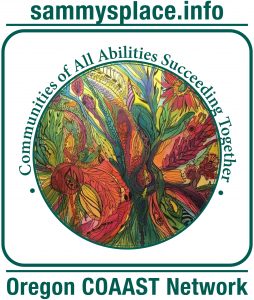EDITOR’S NOTE: Pioneer readers are familiar with Andrew Jenck’s writing – from his popular movie reviews to commentary about movies and more, he always has something important, news worthy to share. This is one of his most personal columns – in partnership with Sammy’s Place and Oregon COAAST network – Andrew tells his story about how he navigates with help and support from family and friends with Asperger’s Syndrome. He provides valuable insight into the communication and social challenges faced by many with autism spectrum disorders. Here’s Andrew’s “View from Here …”
By Andrew Jenck
A Kindergartener takes a Winnie the Pooh lunchbox every day to school. Nothing unusual for a five-year-old; fitting for his age. Now, imagine that same kid keeping the lunchbox all the way up to the fourth grade. His classmates have Spider-Man and Star Wars on their lunchboxes, but the kid is content with keeping the one with the yellow teddy bear. If you were to ask the kid why not get a new one, he’d answer, “Because it was a perfectly fine lunchbox of course! It fits into my backpack nicely, stores all my food in an organized way, and is easy to carry. What reason is there to change it?” If you were to ask how other students may think of him, he’ll say he never thought of it.
This is only one of the examples of my communication disorder as part of my autistic conditions. Autism, or more specifically Asperger’s Syndrome in my case, gives me greater insights to a variety of things while disabling common skills. Communication especially is harder for Autistic people of all ages; social cues are cryptic and are often a second thought. Any common issues of communicating, i.e., public speaking, job interviews, meeting new people get exemplified.
Asperger’s Syndrome was discovered just several years before my birth, brought to my mom’s attention by her friend. Any sort of therapy or exercises were very new and often change within in several months, as more was discovered about the syndrome. I didn’t know what these were for at the time, they were just things I had to do like make my bed or clean my room. They could feel tedious, especially traveling several hours to see my therapist on three-day weekends. These exercises would focus on my hand eye coordination, critical thinking, etc.
My social life for the first half of my childhood was minimal. Most kids were nice to me, though few could get me to talk more than a few sentences. Performing a physical activity (swinging, bouncing a ball, etc.), I daydreamed about my favorite TV shows, cutting myself off from reality. The lack of awareness hindered my ability to understand social interactions and how to manage emotions.
School demonstrated my strengths and weaknesses throughout. Like many Aspies, I excelled at mathematical and analytical studies, but struggled at literacy. Reading comprehension proved difficult, feeling overwhelmed by too much information that I couldn’t even name the main character. I collaborated with my teachers and tutors to find the solution: take each sentence one at a time, read the questions first and highlight any important information. This was only one example of trying to get through many issues.
The first half of my childhood was difficult but still an overall positive one because my parents, teachers, and therapists invested the time to helping me. When I was young, I would get sensory overload from large crowds, but now the disability has subsided. I would experience other challenges in the coming years, and currently still do. It’s a continual process of accepting who I am and communicating to others my unique view of the world.
 For more about Sammy’s Place – MISSION: Creating living, working, and respite opportunities and choices, inspired by nature, with people experiencing disabilities and those who share their journey. www.sammysplace.info; https://www.sammysplace.info/sp-in-two-pages-2021/
For more about Sammy’s Place – MISSION: Creating living, working, and respite opportunities and choices, inspired by nature, with people experiencing disabilities and those who share their journey. www.sammysplace.info; https://www.sammysplace.info/sp-in-two-pages-2021/


